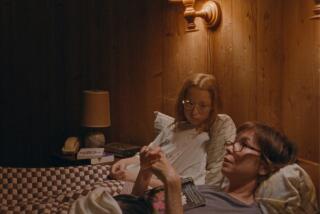Jani’s at the mercy of her mind

January Schofield has schizophrenia. Potent psychiatric drugs -- in doses that would stagger most adults -- seem to skip off her. She is among the rarest of the rare: a child seemingly born mentally ill.
It’s been a rough week. A few days ago, at UCLA’s Resnick Neuropsychiatric Hospital, 6-year-old Jani toppled a food cart and was confined to her room. She slammed her head against the floor, opening a bloody cut that sent her into hysterics. Later, she kicked the hospital therapy dog.
Jani normally likes animals. But most of her animal friends -- cats, rats, dogs and birds -- are phantoms that only she can see. January Schofield has schizophrenia. Potent psychiatric drugs -- in doses that would stagger most adults -- seem to skip off her. She is among the rarest of the rare: a child seemingly born mentally ill.
She suffers from delusions, hallucinations and paroxysms of rage so severe that not even her parents feel safe. She’s threatened to climb into an oven. She’s kicked and tried to bite her little brother. “I’m Jani, and I have a cat named Emily 54,” she says, by way of introduction. “And I’m Saturn-the-Rat’s baby sitter.”
She locks her fingers in front of her chest and flexes her wrists furiously, a tic that surfaces when she’s anxious.
She announces that she wants to be a veterinarian.
“I’m empathetic with rats,” she says.
Asked what “empathetic” means, she smiles confidently. “It means you like rats.”
The doctors have been trying a new antipsychotic medication, called Moban. Jani knows she is sick and that people want to help her.
“Is the Moban working?” her mother asks Jani during a visit.
“No. I have more friends.”
Susan Schofield looks crestfallen.
She and her husband, Michael Schofield, have brought French fries. Jani takes a bite, runs around the room and circles back for another bite.
“You want the rats and cats to go away, don’t you?” Susan asks, trying to make eye contact with her daughter.
Jani stuffs a French fry into her mouth.
“No,” she says. “They’re cool. Rats are cool.”
--
About 1% of adults have schizophrenia; most become ill in their late teens or 20s. Approximately one in 10 will commit suicide.
Doctors and other mental health experts don’t fully understand the disease, which has no cure. Jani’s extreme early onset has left them almost helpless. The rate of onset in children 13 and under is about one in 30,000 to 50,000. In a national study of 110 children, only one was diagnosed as young as age 6.
“Child-onset schizophrenia is 20 to 30 times more severe than adult-onset schizophrenia,” says Dr. Nitin Gogtay, a neurologist at the National Institute of Mental Health who helps direct the children’s study, the largest such study in the world on the illness.
“Ninety-five percent of the time they are awake these kids are actively hallucinating,” Gogtay says. “I don’t think I’ve seen anything more devastating in all of medicine.”
For Jani’s parents, the most pressing issue is where Jani should live. She has been on the UCLA psych ward -- where she was placed during an emergency -- since Jan. 16. The ward is not designed for long-term care.
Jani can’t return to her family’s apartment in Valencia. Last fall, she tried to jump out of a second-story window.
Her parents -- Michael, a college English instructor, and Susan, a former radio traffic reporter -- must decide how to provide as much stability as possible for their daughter while also trying to protect their 18-month-old son.
“If Jani was 16, there would be resources,” Michael says. “But very few hospitals, private or public, will take a 6-year-old.”
Born Aug. 8, 2002, Jani was different from the start, sleeping fitfully for only about four hours a day. Most infants sleep 14 to 16 hours a day. Only constant, high-energy stimulation kept Jani from screaming.
“For the first 18 months, we would take her to malls, play areas, IKEA, anywhere we could find crowds,” says Michael, 33. “It was impossible to overstimulate her. We would leave at 8 in the morning and be gone for 14 hours. We could not come home until Jani had been worn out enough so that she would sleep a couple of hours.”
When Jani turned 3, her tantrums escalated. She lasted three weeks in one preschool and one week in another. She demanded to be called by different names; Rainbow one day, Blue-eyed Tree Frog the next. Make-believe friends filled her days -- mostly rats and cats and, sometimes, little girls.
She threw her shoes at people when angry and tried to push the car out of gear while Michael was driving. The usual disciplinary strategies parents use to teach their young children proper behavior -- time-outs, rules, positive rewards -- failed time and again for the Schofields.
“She would go into these rages where she would scream, hit, kick, scratch and bite. She could say, ‘Mommy, I love you,’ and seconds later switch into being really violent,” Michael says.
Kindergarten lasted one week.
The Schofields consulted doctors and heard myriad opinions: bipolar disorder, attention-deficit hyperactivity disorder, ineffective parenting. No one considered schizophrenia.
In December 2007, they were referred to Dr. Linda Woodall, a psychiatrist in Glendale. Jani’s medical records for the following year depict a doctor searching for effective medications while her patient slid further into a world stalked by rats and cats.
July 8, 2008: Claps hands, hops (tic-like); food can’t touch; strips clothes off if she thinks they have a spot. Wants order and perfection in play, toys, stories.
Nov. 11, 2008: Talking to a “bird named 34” on her hand. Drawing on her clothes and body with permanent marker. Screaming at school and in the waiting room.
Jan. 7, 2009: Patient is psychotic; talking to rats naming them the days of the week . . . I believe it would be in the best interests of January and her family to have her placed in residential treatment.
--
Her parents named her January because they loved the sound of it. But this year, the month of January became the breaking point for a fragile family.
Jani’s torment had escalated through much of 2008. She was hospitalized last fall for three weeks.
Jani tried, and failed, again to attend school. She choked herself with her hands, hit her head on the walls and said she wanted to die.
“Home was a nightmare, and school was a nightmare,” Michael says.
A new imaginary friend named 400-the-Cat moved in. He told her to kick and hit other people. “We realized she didn’t control her imaginary friends. They controlled her,” Michael says. Many phantoms populated her mind now: two little girls named 100 Degrees and 24 Hours; 200-the-Rat; Magical 61-the-Cat; and 400.
Susan, 39, was laid off from her job in September, and although money was tight, she felt almost relieved. Jani needed constant supervision.
Woodall decided to try a new drug, Haldol, 1 milligram, twice a day. It seemed to calm Jani, and 400-the-Cat went away.
The Schofields made another attempt at first grade, sending Jani to school Jan. 12. But that day, the muscles on the left side of her body locked up, and the school called paramedics. She had developed dystonia, a movement disorder that causes involuntary contractions of muscles. It’s a side effect of high doses of some psychotropic medications.
On Jan. 16, Michael dropped his daughter off at school again. “She seemed fine that morning,” he said. She was taking a lower dose of Haldol plus medications to quell psychosis and stabilize mood.
But at 9:15, she began screaming that she wanted to see her brother, Bodhi. She threw her pencils and shoes, tried to jump out of the classroom window, then ran down the halls. The assistant principal called Michael and told him to come and take his daughter home.
Michael was drained.
“I knew if we took her home we couldn’t get any help anywhere,” he says. “We were fed up with nobody believing us, nobody helping us.”
He refused.
The principal called the Los Angeles County Sheriff’s Department and reported that the parents had abandoned their misbehaving child. Three school psychologists were summoned by the assistant principal, and a sheriff’s deputy called for a team of emergency psychiatric workers.
Jani was locked in an empty office playing with 24 Hours. The experts concluded she was psychotic and took her to UCLA.
--
Each day, before the Schofields visit, they stop at a Burger King for lunch and order take-out for Jani.
“So many people just thought we had a bratty kid,” says Michael, feeding Bodhi as he squirms in a high chair in the restaurant. “UCLA was the first to tell us: ‘It’s not your fault -- there is something wrong with her brain.’ ”
When her family arrives, Jani looks surprised to see them although they visit every day. She is wearing a lime-green T-shirt and pink skirt with turquoise rubber shoes. Her hair is tousled. Her legs carry the last traces of baby fat. Susan dabs toothpaste on a toothbrush and runs it over her daughter’s teeth for a few seconds -- the only dental care Jani will allow.
“I’d rather be 16,” Jani says, putting a hand on her hip and tossing a flirty look over her shoulder. “I’m 14 on weekends, Thursdays, Wednesdays and Tuesdays.”
She pauses. “All except for Mondays.”
She loves Littlest Pet Shop toys, miniature animals with houses and furniture, and stacks them on a shelf in her room.
Although she can’t sit still long enough to read a book, she is a voracious learner. She’s also bright -- her IQ is 146. Over the years, Michael and Susan have entertained her by feeding her information well beyond her years: specifics of evolution, the Roman Empire, the periodic table of elements.
“What is the atomic symbol for tungsten?” Susan asks.
“W.”
Jani talks about living in Calalini.
Where is Calalini?
She leans in to whisper her secret.
“Calalini is on the border between this world and my other world.”
--
Jani’s psychiatrist at UCLA, Dr. Karen Lim, has tried several medications. A whopping 300 milligrams of Thorazine manages to stop the psychosis, but it too causes dystonia.
Michael worries that the heavy doses of medication might kill his daughter. But without it, she might kill herself. Jani had recently told Michael that the temperature in Calalini had risen to 200 degrees -- a sign that her hallucinations are worsening. She also says that 400-the-Cat is being really bossy.
On a mid-April afternoon, Michael and Susan meet with Lim and Jani’s social worker, Georgia Wagniere, to discuss the rejections from two residential facilities that primarily care for children who have been abused or neglected but are not severely mentally ill. No one wants to take in a 6-year-old schizophrenic.
“I feel like we’re back to zero again,” Michael says.
Susan proposes that the couple trade in their two-bedroom apartment and rent two one-bedroom units in the same complex. One parent would live with Bodhi and one with Jani on alternating days.
The group discusses the stress on the couple. Both Michael and Susan have relatives who were mentally ill, and both struggle with depression and take antidepressants. They receive no help from their families.
“It’s been very taxing,” Wagniere says. “It has disrupted your entire life; your finances, your mental status.”
“I’m prepared to go the rest of my life like this,” Michael says. “I’m not hanging on to the hope that she’ll get better. My biggest fear is that she won’t live to 18.”
“I have more hope,” Susan says softly, staring at the floor.
Bodhi begins fussing. Michael and Susan thank Wagniere and Lim and leave to visit Jani.
Lim gathers her papers and follows them down the hall. She has recently issued a formal diagnosis of child-onset schizophrenia. The case has tested the limits of the young doctor’s expertise.
“Jani knows she is different from other children,” she says. “She has a degree of insight. She says, ‘If my parents don’t love me, I’ll go live with my rats.’ ”
Lim sighs.
“I would like to give the parents more hope that she won’t kill herself.”
She catches up to Michael and Susan and unlocks the three heavy security doors that separate the children’s unit from the rest of the hospital. Jani’s hair is pulled back in a braid. She begins to show off her Littlest Pet Shops.
A boy hospitalized on the unit passes by the open door of Jani’s room and slams it shut. A stunned look crosses Jani’s face. She pauses for a few seconds, then marches across the room announcing she is going to hit the boy. Michael stops her and tries to redirect her attention to her Pet Shop. But she turns on him, jumping and butting her head under his chin.
He winces and holds her arms as she kicks him in the legs, butts her head into his chest and tries to bite him through his T-shirt. “I just want to hit him! I just want to hit him!”
Hospital staff rush in and restrain her on the bed.
Jani’s wailing rings down the hall. “I just want to hit him!”
About 20 minutes later, a tired Michael emerges from the room to drive home with Susan and Bodhi.
“She’s calm now,” he says. “But the next time she sees him, she’ll hit him.”
--
Finally, a break. A combination of Tegretol, Thorazine and lithium has blunted some of the rage and coaxed a few of the phantoms from Jani’s mind. Lim discharges her June 1 after 133 days in the hospital.
The two apartments are ready. Jani will live in 925; Bodhi, just across the parking lot in 1035. Jani’s apartment is modeled after the psychiatric ward. Her room has only a bed so that, during a tantrum, she can be placed where she won’t hurt herself. The living room is called the day room and is packed with toys and games. The kitchen is the supply room.
The Schofields bought walkie-talkies to communicate between apartments. Michael has written Jani’s schedule on a large white board, just like the hospital staff did: 14:00, occupational therapy; 15:00, quiet time; 16:00, outdoors; 17:00, dinner; 18:00, recreational therapy.
Whoever stays with Jani at night is referred to as her “staff.”
Michael has been worried about paying rent on two places. But, he says, “We want her home. When she’s not in Calalini -- where they all are -- we can have a relationship with her. We want to take what we can get.”
The Schofields have sought home-based special services but aren’t hopeful. They’ve tried to get respite care from a center that helps people with developmental disabilities but were told the service was available only for parents of autistic children.
“We’ve developed sort of a bunker mentality,” Michael says. “Every time Susan and I have relied on other people, we’ve been disappointed.”
Jani’s school, however, will take her back, in a special-education classroom.
The family arrives at Jani’s new home around 3 p.m. on a Monday.
“Honey!” Jani shouts, running across the parking lot to hug the family dog she hasn’t seen in 4 1/2 months.
The wide-eyed, penetrating gaze Jani wore in the hospital -- when she stared as if trying to see into a person’s brain -- is gone. She has spoken little of 400-the-Cat in recent days. But she flaps her hands and rarely stops moving as Michael and Susan show her a cupboard full of prizes she can earn with good behavior. As she becomes familiar with the three small rooms, she begins to relax. She laughs when Bodhi fusses. Friends have come by to visit and share in the homecoming.
“This is actually a very happy day,” says Michael, as he takes in the scene. “She has beaten back probably the most severe mental illness known to man. My hope now is that we can maintain this stability for a while.”
Jani opens the door to a small balcony where her parents have set up an easel with paper, markers, paints and chalk. She grabs chalk, scribbles on the board and looks up at her parents, grinning.
“Oh-oh,” says Susan, with a sigh. She steps back and calls for Michael to have a look. He does. He says nothing.
400.
shari.roan@latimes.com
More to Read
Sign up for Essential California
The most important California stories and recommendations in your inbox every morning.
You may occasionally receive promotional content from the Los Angeles Times.










